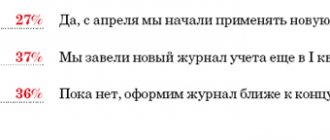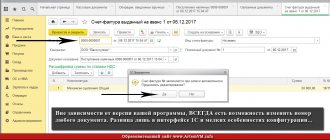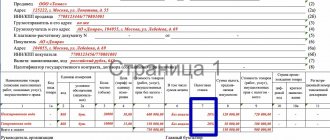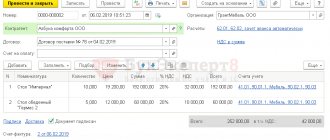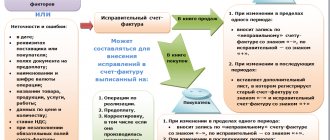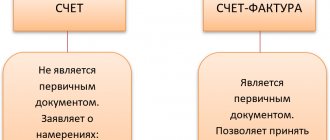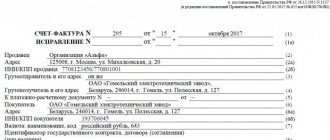Why is VAT clarification needed?
Submitting an updated or corrective VAT return to the Federal Tax Service allows the taxpayer to correct errors made in the previously submitted version of this document.
If an understatement of the accrued tax amount is detected, filing an updated VAT return is mandatory (Clause 1, Article 81 of the Tax Code of the Russian Federation). The legislation does not oblige the VAT return to be adjusted, in which the tax amount was overestimated, but the taxpayer is interested in it himself. The tax inspectorate, when conducting a desk audit initiated due to the filing of an updated VAT return that reduces the amount of tax payable, has the right to request an explanation from the taxpayer (clause 3 of Article 88 of the Tax Code of the Russian Federation). The explanations (or calculation) must contain the justification for the changes made to the updated VAT return, and the taxpayer must provide them within 5 days after receiving such a request.
If an adjustment VAT return is submitted 2 years after the end of the reporting period in order to make corrections, then in accordance with clause 8.3 of Art. 88 of the Tax Code of the Russian Federation, the tax office may request from the taxpayer not only explanations on the updated VAT return, but also primary documents and analytical registers.
Read more about analytical registers in the article “Tax accounting registers for VAT: fixing them in accounting policies .
Filing an updated VAT return, as a rule, entails a request for clarification (or, conversely, the update itself serves as a response to the tax authorities’ request).
ConsultantPlus experts will help you correctly draw up explanations for the updated VAT return. Get trial access to the system for free and go to the Ready-made solution.
How to fill out an updated declaration
How to correct a VAT return? How to make an adjustment VAT return? If the question arises of how to make a VAT declaration that clarifies the values already filed, then the answer is simple: you need to draw up a new declaration with the correct amounts. How to fill out an updated VAT return? It is necessary to enter all the values into it completely, and not display only the difference between the erroneously submitted and correct ones. Thus, a sample of an updated VAT declaration is a regular declaration, only containing the correct (updated in comparison with the previously submitted document) numbers.
Note! The updated declaration is filled out on the form that was in force during the period for which changes are made (clause 5 of Article 81 of the Tax Code of the Russian Federation). Since November 2021, a new VAT declaration form has been in effect as amended by Order No. ED-7-3 dated August 19, 2020/ [email protected]
For step-by-step instructions on how to fill out an updated VAT return, starting with the reporting campaign for the 4th quarter of 2021, see ConsultantPlus, having received trial demo access to the K+ system. It's free.
As for tax agents, in the clarification they display information only for those taxpayers for whom errors were discovered.
A sign of an updated document is a special code (adjustment number), which must be indicated on the title page in a separate field in the VAT return. The correction number corresponds to the serial number of the clarification submitted for the tax period in which the errors were discovered.
Another point that distinguishes the updated VAT return is the indication of relevance in sections 8 and 9. The relevance code in the updated VAT return has 2 meanings (clauses 46.2, 48.2 of the Filling Out Procedure, approved by Order of the Federal Tax Service of Russia dated October 29, 2014 No. ММВ-7-3/ [email protected] ):
- 0 - if in the original version of the declaration sections 8, 9 were not filled out or changes are made to them;
- 1 - if these sections do not require data correction.
Making changes requires filling out appendices to sections 8, 9. The design features of these sections and appendices to them are described in the letter of the Federal Tax Service of Russia dated March 21, 2016 No. SD-4-3/ [email protected]
Read about common errors in filling out returns in the article “Tax officers summarize errors: check your VAT return .
IMPORTANT! It should be taken into account when submitting a clarification, by which it will be possible to judge the overpayment of tax, that the tax office reimburses the overpaid amount of tax (or makes a credit) only if three years have not yet passed from the date of payment of the “excess” tax (clause 7 of Art. 78 Tax Code of the Russian Federation).
You can submit an update to receive a VAT deduction within 3 years after goods (work, services, property rights) are registered or imported into the territory of Russia (clause 1.1 of Article 172 of the Tax Code of the Russian Federation).
If clarifications are submitted for the period in which a single (simplified) declaration form was submitted, you should submit the usual (full) declaration form, but indicate on it that this is a clarification. This is done if taxable transactions are indicated for which information about their absence was previously provided (in the reporting period). This norm was clarified by the Russian Ministry of Finance in its letter dated October 8, 2012 No. 03-02-07-1-243.
If the taxpayer has changed the registration address and switched to service in another Federal Tax Service, then the clarification is submitted to the new tax office, but the form itself indicates the OKTMO (OKATO) code of the previous territorial tax service (letter of the Federal Tax Service of the Russian Federation for Moscow dated October 30, 2008 No. 20-12 /101962).
Formation of sections
The primary report must have a title page and section 1. The remaining sections 2–12 and appendices to 3, 8 and 9 must be completed and included in the report only if the corresponding transactions were carried out during the tax period. Therefore, if the primary report contained, for example, sections 1, 2, 3, 7 and 9, then the clarification submitted as part of the same transactions performed must contain them.
If it is necessary to make corrections to the purchase book, for example, to cancel an entry on an invoice, then he must be guided by the requirements of Decree of the Government of the Russian Federation dated December 26, 2011 No. 1137. It follows from it that all changes and amendments in the book of sales and purchases that need to be made after the end of the tax period should be made by inserting additional sheets. As follows from the legislation, the report in Appendix 1 to Section 8 and Appendix 1 to Section 9 is adjusted to reflect information from additional sheets of the sales book and purchase book. Correct the purchase book and fill out the indicated applications.
If the taxpayer made such amendments, then as part of the clarification, in addition to the main sections 1, 2, 3, 7 and 9, previously presented as part of the primary reporting form, it is necessary to submit Appendix 1 to Section 8 with additional sheets from the purchase and sale books.
In order to save taxpayers from duplicating data when correcting it, the Federal Tax Service allows the use of the relevance indicator. This permission is due to the huge volume of data transferred under sections 8–12. If there are no changes or clarifications, leave it blank. The relevance indicator is “1”. This means that the Federal Tax Service will automatically save the data from the previous reporting form for the same period. If there is a need to make changes to all sections, then the relevance indicator “0” is set for all sections, and then the updated data is uploaded, which will be used for tax control purposes.
Using the relevance sign allows taxpayers to independently generate the number of clarification sections, information on which will be changed in the Federal Tax Service database. This applies even to interrelated sections, provided that an error was made in only one of them in the previous tax period. In addition, the Federal Tax Service allows the taxpayer the right to refuse to correct the appendices to sections 8 and 9, even if they are marked “0” and the information is re-uploaded.
However, such permission from the tax authorities contradicts the rules for maintaining a purchase book and a sales book approved by the Government of the Russian Federation. Considering this approach of officials to the procedure for reflecting changes in tax accounting documents, it is recommended to completely unload corrections from the books rather than receive a punishment if suddenly, after an inspection by the Federal Tax Service, the case is considered in court.
It should be noted that it is almost impossible to find an example of filling out a clarification that is suitable for all situations, since everyone’s errors are different. Therefore, if explanations are needed for the updated VAT return, the sample can only be found in the instructions for the regular report form, by analogy.
If you generate reports in the “Taxpayer Legal Entity” program, we will briefly tell you how to make an updated declaration in the Taxpayer: after generating the main declaration, the “U” button is available, which offers various options:
- creating an adjustment;
- change of correction number;
- deletion of declaration.
Select “Add updated calculation”, enter the update number.
Procedure for submitting an update in 2021
How to submit an updated VAT return? Are there deadlines for filing an updated VAT return? Currently, taxpayers are required to file tax returns electronically. In accordance with paragraph 5 of Art. 174 of the Tax Code of the Russian Federation, declarations submitted on paper instead of the mandatory electronic format are considered unfiled.
These norms also apply to updated declarations (letter of the Federal Tax Service of Russia dated March 20, 2015 No. GD-4-3 / [email protected] ). Therefore, in 2021 they are also submitted in electronic format.
But there are no specific deadlines for submitting clarifications. In this case, it is better to submit it immediately after independently identifying the error, since detection of this error by the tax authority can lead to a fine.
What are the types of adjustment invoices?
There are three types of invoices:
- adjustments for reduction (if the supply price decreases);
- adjustments for increases (if the supply price increases);
- adjustments with data on simultaneous changes in the price and (or) quantity of goods (work, services, property rights).
An adjustment invoice of any of these types can be issued for one original invoice, or for several. In the latter case, the document is called a single adjustment invoice (clause 5.2 of Article 169 of the Tax Code of the Russian Federation).
Consequences of submitting a clarification
If an update is submitted during the period when the deadline for filing the reporting declaration has not yet expired, then it is considered not updated, but submitted on time (clause 2 of Article 81 of the Tax Code of the Russian Federation). If a clarifying return is submitted after the end of the period allotted for filing the report, but before the end of the tax payment, then the taxpayer can avoid liability if this error was not discovered earlier by the tax authority.
You can avoid being held accountable when submitting an update after the end of the tax payment period if:
- before filing such an amended declaration, the arrears of tax and penalties on the amended VAT declaration were paid;
- the tax authority did not detect this error if an audit was carried out before the clarification was submitted.
You can learn more about how clarification helps you avoid sanctions from the ConsultantPlus material. The full text of the Ready Solution can be viewed by receiving a free trial access to K+.
A payment order for additional payment of VAT on an updated declaration is drawn up in the usual form, indicating in it the period for which the additional payment is made and the type of payment corresponding to the repayment of the debt (ZD instead of TP).
If an updated declaration is submitted at the time of a desk audit of the previous declaration, then the tax office must stop the ongoing audit (clause 9.1 of Article 88 of the Tax Code of the Russian Federation). Now a desk audit can begin after the clarification has been submitted.
If an amendment is submitted and the arrears are paid, but the penalty is not paid, a fine is imposed on the taxpayer (Resolution of the Presidium of the Supreme Arbitration Court of the Russian Federation dated April 26, 2011 No. 11185/10).
The tax inspectorate may schedule a second on-site inspection when the taxpayer submits an updated return that reduces the amount of VAT, after completing the previous on-site inspection and drawing up a report on its results (subclause 2, paragraph 10, article 89 of the Tax Code of the Russian Federation, letter of the Ministry of Finance of Russia dated December 21, 2009 No. 03 -02-07/2-209 and Resolution of the Presidium of the Supreme Arbitration Court dated March 16, 2010 No. 8163/09).
In relation to taxpayers whose control is carried out in the form of tax monitoring, when they submit an updated declaration with a reduction in the amount of tax payable, an on-site inspection may also be assigned (subclause 4, clause 5.1, article 89 of the Tax Code of the Russian Federation).
For information on how an on-site audit is carried out, read the material “Procedure for conducting an on-site tax audit (nuances)” .
Procedure for filing an updated VAT return
The procedure for filing an updated VAT return is specified in Art. 81 Tax Code of the Russian Federation.
It is served when:
- the amount of the recalculated tax is less than the value indicated in the already submitted declaration;
- the recalculated VAT amount is greater than that indicated in the already submitted declaration.
With a reduced amount due
If a taxpayer submits a VAT return to reduce the amount of tax paid, a desk audit will immediately follow. If an on-site inspection has not been carried out for a long time, then it may take place.
If during an audit the tax authorities confirm the fact of a VAT reduction, then an overpayment will appear on the taxpayer’s personal account.
It can be returned to the taxpayer’s current account, or “put” into offset for VAT or other taxes.
In any case, the taxpayer will need to write an application addressed to the head of the tax office for either a refund or a credit.
Additional VAT payment required
If you need to submit an “adjustment” for VAT when the tax increases, and pay additional tax, then you first need to pay the amount of the underpayment, and then submit a declaration.
This procedure is necessary so that tax authorities do not “overwhelm” the taxpayer with a fine for late non-payment of taxes.
However, tax authorities may impose penalties on the amount of non-payment. They will also need to be paid before filing an adjustment return. The difference between the payment deadline and the submission deadline may be minimal.
If the taxpayer sees that the amount of the additional payment has reached the recipient, he can submit the declaration on the same day. But, as a rule, it must be submitted the next business day.
Tax authorities often impose a fine under Article 122 of the Tax Code of the Russian Federation. For a clearer understanding, you can read the Comments on this article.
However, if the taxpayer “managed” to pay both the fine and penalties before the desk audit, the fine can be challenged in court. If you don’t have time, the fine must be paid as quickly as possible.
When to submit an adjustment (filing deadlines)
Depending on when the error in the calculations was discovered, the deadline for filing an updated VAT return also depends.
If a taxpayer has discovered an error for the current tax period, he must submit an “update” as quickly as possible.
How to pay VAT, see the article: payment of VAT.
What to do with the new VAT return.
If the adjusted declaration is submitted before the deadline for filing a VAT return for the current tax period, then the tax authorities “count” the corrective declaration. Only the error must be for the same tax period.
If the taxpayer submits an updated return after the deadline for submitting the VAT return, but before the due date for payment, then the tax authorities will not impose a fine or penalty on him.
The fact is that the taxpayer “corrected” before the tax inspectors discovered the error.
If the taxpayer submits a “clarification” when all deadlines have already passed, he is subject to liability under Art. 122 – for late payment of tax.
However, in paragraph 4 of Art. 81 of the Tax Code of the Russian Federation lists cases when a taxpayer can avoid liability for a tax offense.
These are cases such as:
- if the taxpayer discovered an error and paid the arrears with penalties earlier than this fact was discovered by the tax authorities;
- if, after filing an updated declaration, an on-site or desk audit was carried out, during which the tax authorities did not find the error indicated by the taxpayer.
You must submit an adjustment return within the same deadline as provided for filing a return in this tax period - before the 20th day of the month following the end of the tax period, that is, the quarter.
Results
The taxpayer submits an amended return if errors are discovered after the end of the tax period that lead to a decrease/increase in the tax amount. The update is drawn up on the form that was in effect in the adjusted period and submitted to the Federal Tax Service in electronic format. If, as a result of correcting an error, a tax arrear has arisen, it must be repaid along with the payment of a penalty until the time of filing the updated declaration. And if, when submitting a clarification, an overpayment of tax occurs, the possibility of an on-site audit on it cannot be ruled out.
Sources:
- Tax Code of the Russian Federation
- Order of the Federal Tax Service of Russia dated October 29, 2014 No. ММВ-7-3/ [email protected]
You can find more complete information on the topic in ConsultantPlus. Free trial access to the system for 2 days.
